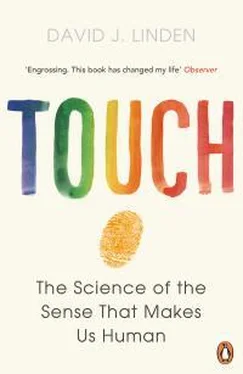44. The organization of the secondary somatosensory cortex is poorly understood, but it is becoming clear that, like the primary somatosensory cortex, it is composed of functionally distinct areas, some of which receive only tactile (cutaneous) signals and others that receive a mixture of tactile signals and information about the conformation of the hand/limb/body (proprioceptive signals). P. J. Fitzgerald, J. W. Lane, P. H. Thakur, and S. S. Hsiao, “Receptive field properties of the macaque second somatosensory cortex: evidence for multiple functional representations,” Journal of Neuroscience 24 (2004): 11193–204.
45. This was clearly shown in a series of experiments by Esther Gardner and her colleagues at New York University School of Medicine, who recorded from the posterior parietal cortex in monkeys trained to reach and grasp objects. They found that neurons in this region became active while the monkey was reaching for an object, long before the object was touched. Furthermore, the firing patterns of these neurons during reaching appeared to reflect predictions about the anticipated efficiency of the reaching movements. The neural responses after contacting an object can then either confirm or rebut these predictions, thereby providing the information for the monkey to learn to optimize its reaching movements as a result of experience, i.e., motor learning. J. Chen, S. D. Reitzen, J. B. Kohlenstein, and E. P. Gardner, “Neural representation of hand kinematics during prehension in posterior parietal cortex of the macaque monkey,” Journal of Neurophysiology 102 (2009): 3310–28.
46. T. Elbert, C. Pantev, C. Weinbruch, B. Rockstroh, and E. Taub, “Increased cortical representation of the fingers of the left hand in string players,” Science 270 (1995): 305–7; I. Hashimoto, A. Suzuki, T. Kimurs, Y. Iguchi, M. Tanosaki, R. Takino, Y. Haruta, and M. Taira, “Is there training-dependent reorganization of digit representations in area 3b of string players?” Clinical Neurophysiology 115 (2004): 435–47; and P. Schwenkreis, S. El Tom, P. Ragert, B. Pleger, M. Tegenthoff, and H. R. Dinse, “Assessment of sensorimotor cortical representation asymmetries and motor skills in violin players,” European Journal of Neuroscience 26 (2007): 3291–3302. What are the functional consequences of having an expanded left hand representation in the touch map? The last study went on to show that motor performance was not enhanced in either the left or right hand of musicians as compared with nonmusicians. These authors did not test tactile discrimination, however.
47. C. Xerri, J. M. Stern, and M. M. Merzenich, “Alterations of the cortical representation of the rat ventrum induced by nursing behavior,” Journal of Neuroscience 14 (1994): 1710–21; and C. Rosselet, Y. Zennou-Azogui, and C. Xerri, “Nursing-induced somatosensory plasticity: temporally decoupled changes in neuronal receptive field properties are accompanied by modifications in activity-dependent protein expression,” Journal of Neuroscience 26 (2006): 10667–76. Inquiring minds want to know: Does this map plasticity also occur in breast-feeding humans?
48. J. O. Cog and C. Xerri, “Tactile impoverishment and sensorimotor restriction deteriorate the forepaw cutaneous map in the primary somatosensory cortex of adult rats,” Experimental Brain Research 129 (1999): 518–31.
49. C. F. Bolton, R. K. Winkelmann, and P. J. Dyck, “A quantitative study of Meissner’s corpuscles in man,” Neurology 16 (1966): 1–9; M. F. Bruce, “The relation of tactile thresholds to histology in the fingers of elderly people,” Journal of Neurology, Neurosurgery and Psychiatry 43 (1980): 730–34; J. C. Stevens and K. K. Choo, “Spatial acuity of the body surface over the life span,” Somatosensory and Motor Research 13 (1996): 153–66; and K. L. Woodward, “The relationship between skin compliance, age, gender and tactile discriminative thresholds in humans,” Somatosensory and Motor Research 10 (1993): 63–67
50. R. W. Van Boven, R. H. Hamilton, T. Kauffman, J. P. Keenan, and A. Pascual-Leone, “Tactile spatial resolution in blind braille readers,” Neurology 54 (2000): 2230-2236; and D. Goldreich and I. M. Kanics, “Tactile acuity is enhanced in blindness,” Journal of Neuroscience 23 (2003): 3439–45. The observation of superior performance by women in these tactile acuity tasks was an outgrowth of the main topic of these studies, effects of blindness. We’ll address the effects of blindness on touch perception in later chapters.
51. R. M. Peters, E. Hackeman, and D. Goldreich, “Diminutive digits discern delicate details: fingertip size and the sex difference in tactile spatial acuity,” Journal of Neuroscience 29 (2009): 15756–61; and M. Wong, R. M. Peters, and D. Goldreich, “A physical constraint on perceptual learning: tactile spatial acuity improves with training to a limit set by finger size,” Journal of Neuroscience 33 (2013): 9345–52. Of course, there are some caveats. First and foremost, the assumption that sweat pore density is a good proxy for Merkel disk density awaits confirmation. Second, while, statistically speaking, fingertip size could explain most of the variation in tactile acuity, this finding does not rule out the possibility that there are also sex differences in the brain’s touch circuits that also contribute to tactile acuity differences. Goldreich and colleagues went on to ask, on average, do children, with their tiny fingers, have even better tactile acuity than women? The answer is interesting. On average, children’s sweat pores, and hence, presumably, their Merkel disks, are indeed spaced more closely. And at a given age, children with larger fingertips had significantly poorer acuity. However, acuity did not worsen with age in children as their fingertips grew. The authors propose that while finger growth in childhood reduces density of the Merkels, this is compensated for by a simultaneous increase in the ability of the brain to extract information from these sensors. R. M. Peters and D. Goldreich, “Tactile spatial acuity in childhood: effects of age and fingertip size,” PLOS One 8 (2013): e84650.
52. Are there a fixed number of mechanosensors on the female breast? In my limited erotic experience, women with smaller breasts also tend to be more responsive to gentle stimulation of that area. When I shared this idea with Z., she observed, “The size of the breast isn’t relevant because the tactile hot spot is the nipple and areola. The surrounding skin of the breast is much less sensitive.” She pointed out that while nipple size and breast size aren’t correlated, areola size and breast size are. So it’s possible that women with larger breasts have decreased mechanosensor density in the areola. However, it’s also possible that mechanosensor density has little to do with erotic response. We’ll talk about that in the next two chapters. Later, I came across the following publications. They report that many women seeking breast reduction surgery complain of a lack of sensation in the nipple/areola region. These anecdotal reports were confirmed experimentally: When tactile sensitivity of the areola was measured using standard filaments, two-point discrimination thresholds or vibration, large-breasted women (D-cup size or larger) were consistently less sensitive than small-breasted women (A or B cup). S. Slezak and A. L. Dellon, “Quantitation of sensibility in gigantomastia and alteration following reduction mammoplasty,” Plastic and Reconstructive Surgery 91 (1993): 1265–69; and Y. Godwin, K. Valassiadou, S. Lewis, and H. Denley, “Investigation into the possible cause of subjective decreased sensory perception in the nipple-areola complex of women with macromastia,” Plastic and Reconstructive Surgery 113 (2004): 1598–1606.
Читать дальше












